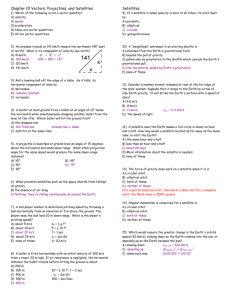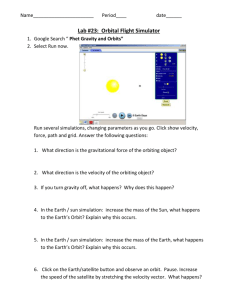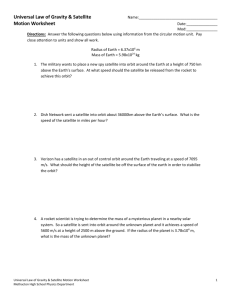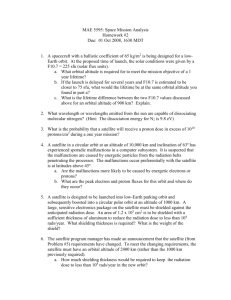NAME:
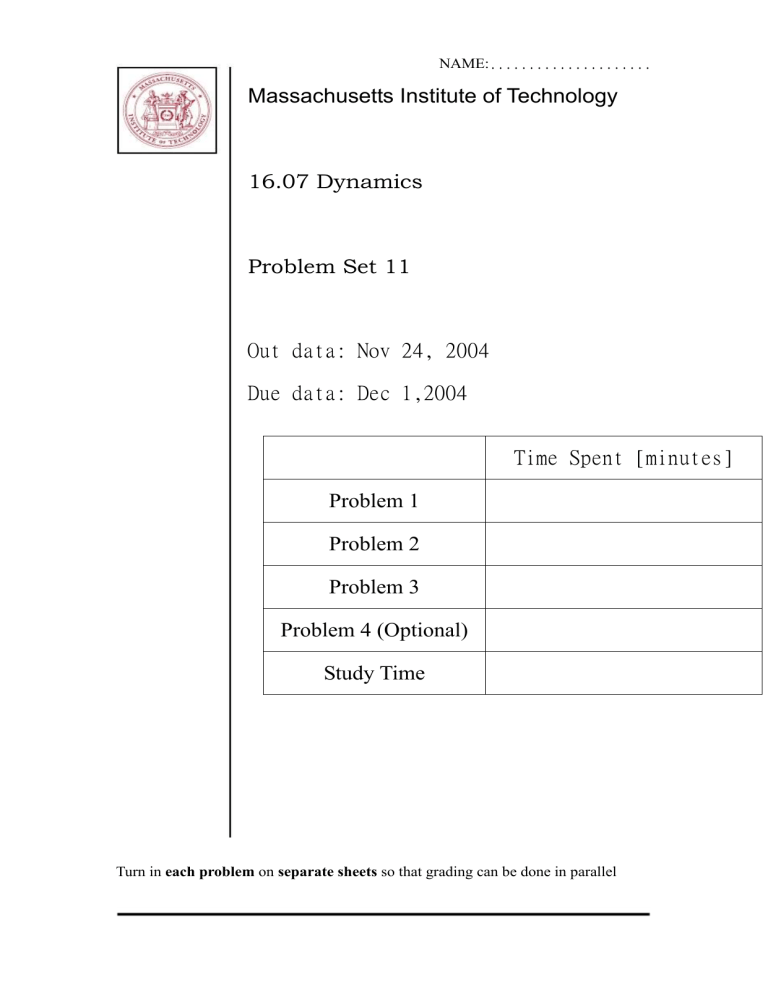
NAME: .....................
Massachusetts Institute of Technology
16.07 Dynamics
Problem Set 11
Out data: Nov 24, 2004
Due data: Dec 1,2004
Problem 1
Problem 2
Problem 3
Problem 4 (Optional)
Study Time
Time Spent [minutes]
Turn in each problem on separate sheets so that grading can be done in parallel
Problem 1
Part A
A 20000 kg rocket carries 17000 kg of propellant and is launched vertically from rest.
We consider two possible engines:
1) Engine A burns propellant at a constant rate of 80 kg/s and gives an exhaust velocity of 2500 m/s.
2) Engine B burns propellant at a constant rate of 160 kg/s and gives an exhaust velocity of 2500 m/s.
Assuming a constant gravity of 9.8 m/s
2 and neglecting air resistance, determine, for each engine, the velocity and height of the rocket at burn out, and the maximum height reached.
Part B
We need to place a payload of mass mL = 100 kg into low earth orbit. This requires a
Δv = 9000 m/s. Assuming that the tank plus engine weighs 10% of the propellant it can carry and that the engines available can deliver an exhaust velocity of 3000 m/s, calculate the total mass of the rocket at take off under the following assump-tions/conditions:
1) single stage neglecting effects of aerodynamic drag and gravity.
2) two stages of Δv = 4500 m/s each, neglecting effects of aerodynamic drag and gravity. Here we shall assume that the tank plus engine released after the first stage has a weight of 10% of the propellant it can carry.
Problem 2
Part A
A satellite of mass m =100 kg is in nearly circular orbit about the earth. At the instant considered, the period of the orbit is 6300s.The satellite experiences a very small drag due to friction with the extreme upper atmosphere and as a result the satellite slowly spirals towards the earth. Since the friction is weak, the change in radius is slow and therefore we can assume that at any instant the satellite is in circular orbit. From measurements we determine that the period of the orbit decreases by 0.15 s every orbit. For the instant considered, determine a) the radius of the orbit and the change in radius per orbit, b) the drag force, and,
c) the change in kinetic energy per orbit. Does the kinetic energy increase or decrease as a result of the drag force?. Explain.
Part B
Two particles of mass M = 20kg and m =5kg, are released at t = 0 with velocities V
M
=10m/s and V m
=23m/s as shown. The two particles move under the only action of an attracting force between them of magnitude F = G
′
Mm/r
2
, where G
′
=80 N m
2
/ kg
2
, and r is the distance between the particles. Show that the trajectory of m relative to M is an ellipse, and determine the period, T, of the orbit. Give also the position of both particles at t = T.
Problem 3
Part A
Satellite A moving in the circular orbit and satellite B moving in the elliptical orbit collide and become entangled at point C. If the masses of the satellites are equal, determine the maximum h of the resulting orbit max
Part B
A satellite is in an elliptical orbit around the earth with r
=6, 600 km and r
=6,
900 km. In order to transfer the satellite to a circular orbit of radius r =100, 000 km we consider a) a two impulse Hohmann transfer starting at the perigee of the initial elliptical orbit. b) a two impulse Hohmann transfer starting at the apogee of the initial elliptical orbit. c) a three impulse Hohmann transfer starting at the perigee of the initial orbit. In this case, we consider two locations for the point P: rP =200, 000 km, and rP
=300, 000 km.
For all the above cases determine the total v required (sum of absolute values of
T the individual ' .) Which option requires the smallest v
T
?. Determine also the transfer time and the mass ratio m f
/ m
0
of the satellite, assuming an engine capable of c = 3000 m/s (here m is the mass of the satellite in the initial elliptic orbit, and
0 m f
is the mass of the satellite in the final circular orbit).
Problem 4
THIS PROBLEM IS OPTIONAL. STUDENTS WHO COMPLETE IT
SUCCESSFULLY WILL EARN EXTRA CREDIT EQUIVALENT TO ONE
HOMEWORK PROBLEM.
Part A
We have seen that for central force motion the total mechanical energy is conserved,
Also h
r
2
.
=constant and v
2
.
r e r
r
.
( )
2
(since v
.
r e r
.
r e
). a) Show that we can write an energy equation for r and
.
r only, as is the effective potential energy per unit mass. The term h
2
/(2r
2
)is called the centrifugal potential. b) Sketch V eff r c) Equation (1) governs the motion in the radial direction of the trajectory of a particle under a central force. Determine the equilibrium points (i.e. points where
.
r = 0 for all times, if initially
.
r = 0). Are the equilibrium points stable?, what trajectories do they represent? d) For a given angular momentum h, what is the trajectory with the smallest energy
E?
Part B
Compute the magnitude of the necessary launch velocity at B and the angle α that the trajectory makes with the local horizontal, if the projectile trajectory is to intersect the earth’s surface so that the angle β equals 90 o
.The altitude at the highest point of the trajectory is 0.5R.

